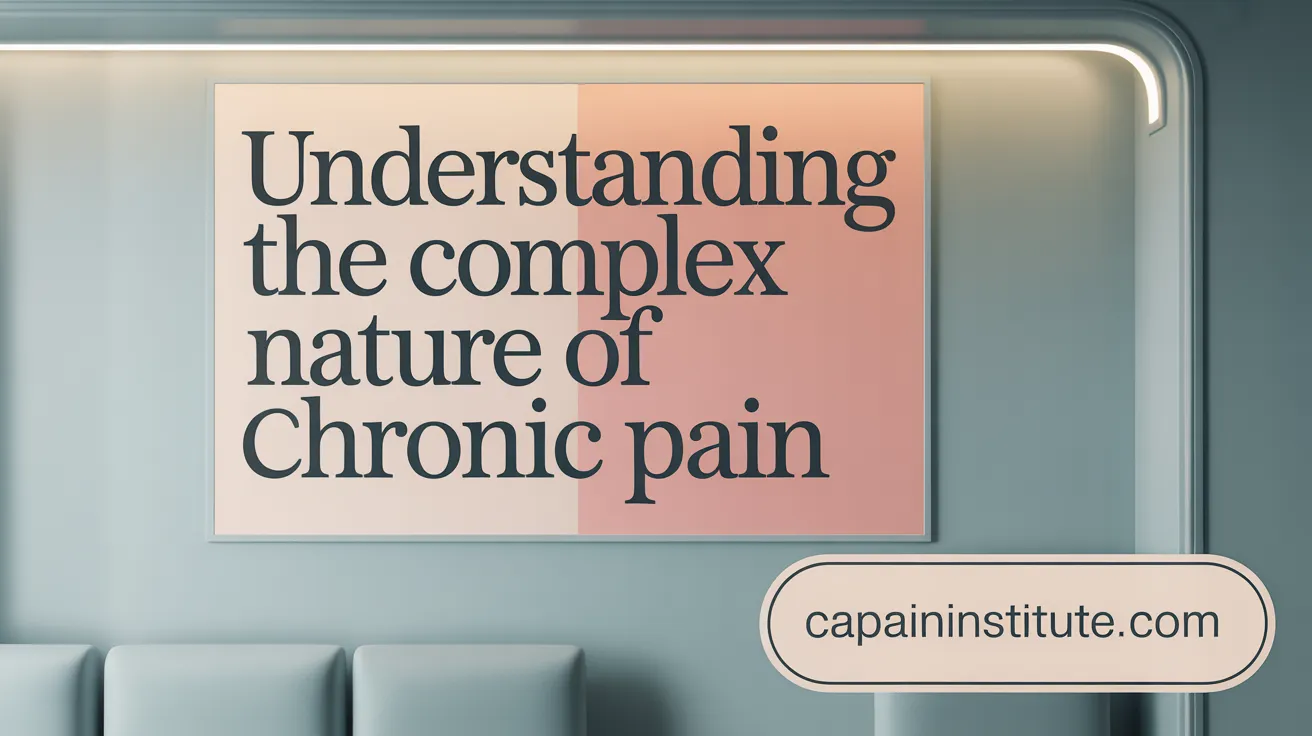Understanding Chronic Pain and Its Complexities
Chronic pain is a pervasive health challenge impacting nearly one-third of adults in the United States. Unlike acute pain, chronic pain persists for more than three to six months and often involves complex changes in the central nervous system, including heightened sensitivity in the brain and spinal cord. Its subjective nature and multifaceted causes—from injury and illness to neurological sensitization—make effective management a nuanced endeavor. This article explores practical, evidence-based techniques for controlling chronic pain, emphasizing a multidisciplinary approach that integrates medical treatment, lifestyle adaptations, and mind-body strategies to improve function and quality of life.
The Biological and Psychological Complexity of Chronic Pain

What is chronic pain and how prevalent is it?
Chronic pain is defined as pain that lasts beyond three to six months. It may be continuous or come and go over time, affecting roughly 30% of people in the United States. This long-lasting pain can arise from past injuries, illnesses like arthritis, or sometimes with no clear physical cause. The condition significantly disrupts daily life, diminishing quality of life, work productivity, social relationships, and emotional well-being. For detailed statistics and overview, see Chronic Pain in the U.S. and Chronic Pain Overview.
How does central sensitization affect the experience of chronic pain?
Central sensitization is a critical biological process in chronic pain. It refers to heightened sensitivity within the central nervous system—the brain and spinal cord—which amplifies pain signals. This makes the pain perception stronger and often more widespread than initial injury or tissue damage would explain. Due to involvement of multiple pain pathways, it becomes challenging to identify the original source of pain. Central sensitization can maintain pain even after healing, resulting in persistent discomfort and pain hypersensitivity. Learn more about Central nervous system and pain and Pain pathways and central sensitization.
Why is pain considered a subjective experience?
Pain is inherently subjective and cannot be quantified through objective tests like blood work or imaging. Instead, healthcare providers rely on patients to report their pain intensity, often using scales from 0 to 10. Each individual's pain perception is influenced by complex neurological and psychological factors, meaning that two people with similar injuries may experience and describe their pain very differently. This subjectivity underscores the need for personalized assessment and management. For more on Pain measurement challenges and Pain rating scale, see the resources.
What psychological factors exacerbate chronic pain?
Psychological and social influences strongly affect chronic pain intensity and impact. Factors such as stress, depression, anxiety, and social isolation can intensify pain perception. Variations in activity levels, whether overexertion or underactivity, also worsen symptoms. These elements contribute to a vicious cycle where pain leads to negative moods and social withdrawal, which in turn amplify the sensation of pain. Addressing psychological contributors is therefore essential in managing chronic pain effectively. Explore Mental health and chronic pain and Treating depression and anxiety.
What is the impact of chronic pain on mental health and daily functions?
Chronic pain often leads to emotional distress including depression, anxiety, and sleep disturbances. These mental health challenges exacerbate pain, reduce coping ability, and impair daily activities such as work, exercise, and social engagement. The 'terrible triad' of pain, sleeplessness, and sadness illustrates this interplay, highlighting the need for holistic care approaches that address both mind and body aspects to improve patient outcomes. For comprehensive insight, see Impact of Chronic Pain on Daily Life and Psychological therapies for pain.
Multidisciplinary Medical Approaches to Chronic Pain Management
What does a multidisciplinary approach to chronic pain entail?
Managing chronic pain effectively requires a multidisciplinary approach that integrates expertise from various healthcare professionals. This includes medical providers, physical therapists, psychologists, and other specialists who collaborate to deliver a comprehensive treatment plan. The care team combines medical treatments, movement therapies, and behavioral strategies customized to the patient's unique condition and preferences. This team-based model addresses the biological, psychological, and social components of pain to improve function and quality of life.
Pharmacological options and considerations
Several classes of medications are utilized to manage chronic pain, depending on the pain type and severity. Nonsteroidal anti-inflammatory drugs (NSAIDs) and acetaminophen are typically first-line agents for mild to moderate musculoskeletal and inflammatory pain. For neuropathic pain, antidepressants like amitriptyline and serotonin-norepinephrine reuptake inhibitors, as well as anticonvulsants such as gabapentin and pregabalin, are commonly prescribed.
While opioids can be effective in certain situations—especially for acute or cancer-related pain—their use in chronic noncancer pain is limited due to risks including dependence, tolerance, overdose, and diminished efficacy over time. NSAIDs carry risks of gastrointestinal, renal, and cardiovascular side effects, whereas acetaminophen can affect liver function if overdosed. Hence, medication choices must balance efficacy against potential adverse effects.
Role of medical specialists
Medical specialists play a vital role in diagnosing pain causes and tailoring treatment strategies. Pain medicine physicians assess inflammatory or connective tissue diseases that might benefit from targeted drugs. Psychiatrists and psychologists provide behavioral therapies like cognitive-behavioral therapy (CBT) to address pain-related emotional distress. Physical therapists guide personalized exercise and movement programs to increase strength and flexibility while reducing pain.
Importance of personalized treatment plans
Each patient’s experience of chronic pain is unique, necessitating individualized treatment plans. These plans integrate medication, physical therapy, psychological support, and lifestyle modifications, taking into account comorbidities such as depression or anxiety. Education about the neurobiological basis of pain helps patients understand their condition and enhances engagement with treatment.
How do clinicians approach opioid therapy for chronic pain?
Opioid therapy for chronic pain is approached with caution. Clinicians conduct comprehensive assessments—including patient history and risk factors—to determine appropriateness. Opioids are prescribed at the lowest effective doses with clear treatment goals and regular monitoring for signs of misuse, tolerance, or hyperalgesia. Non-opioid therapies and multidisciplinary care remain the foundation of management, especially for patients with substance use disorders. In all cases, collaboration among healthcare providers ensures safe and effective pain control.
Physical Activity and Therapeutic Movement for Pain Relief

How does exercise help manage chronic pain?
Regular gentle exercise such as walking, swimming, gardening, and dancing plays a crucial role in managing chronic pain. These activities block pain signals to the brain and improve muscle and joint flexibility. Exercise also strengthens muscles and reduces inflammation, which together contribute to lasting pain relief and enhanced physical function. For more on exercise benefits and physical therapy, see Physical therapy for chronic pain and Exercise for chronic pain management.
What types of activities are recommended?
Low-impact aerobic activities are especially beneficial. These include:
- Walking
- Swimming
- Cycling
- Gardening
- Dancing
Gradual increases in activity levels improve fitness without causing injury, promoting long-term benefits. See more on gentle exercise benefits and pacing and gradual activity increase for pain relief.
What is the role of physical and occupational therapy?
Physical and occupational therapy provide specialized support to people with chronic pain. Benefits include:
- Improving strength, flexibility, and range of motion
- Teaching pain-appropriate methods to perform daily tasks
- Guiding gradual activity progression to avoid overexertion
- Preserving or enhancing mobility and function
See Physical and occupational therapy for pain management and Physical therapy in pain management.
Why is pacing and gradual progression important?
Pacing involves breaking tasks into manageable parts, working at a slower tempo, and gradually increasing activity. This approach helps prevent setbacks caused by overexertion or underactivity, enabling sustainable improvements in function and pain control. For more, see Effective pacing for chronic pain.
What are the advantages of mind-body exercises like yoga and tai chi?
These practices combine gentle movement, breath control, and mindfulness meditation. They help:
- Reduce pain intensity
- Improve flexibility and balance
- Address psychological contributors like stress and anxiety
- Promote relaxation and body awareness
Learn more about Yoga and tai chi for chronic pain and Mindfulness for pain management.
Incorporating physical activity, therapeutic movement, and paced progression forms a foundation for effective, holistic chronic pain management.
Mindfulness, Relaxation, and Psychological Strategies

How do mindfulness and relaxation techniques aid in pain control?
Mindfulness meditation, deep breathing exercises, biofeedback, and guided imagery are effective mindfulness and relaxation techniques that reduce muscle tension and calm anxiety and stress. These practices work by moderating how the brain processes pain signals, which helps patients better manage the discomfort they experience. By focusing attention and promoting relaxation, they enhance coping skills and lower the emotional distress that often amplifies pain.
What role does cognitive behavioral therapy (CBT) play in pain management?
Cognitive behavioral therapy (CBT) is a psychological intervention that assists patients in reframing negative thoughts about pain and challenging misconceptions such as "hurt versus harm." Through CBT, patients learn to regulate their emotions more effectively and develop healthier attitudes towards activity, promoting engagement rather than avoidance. This shift reduces pain severity and improves physical function.
Why is psychological support important in managing chronic pain?
Chronic pain often coexists with mental health conditions like depression and anxiety. Psychological support is crucial because it helps break the cycle where emotional distress worsens pain and vice versa. Therapies addressing these emotional factors aid in overall pain management, helping patients improve quality of life by dealing not just with physical symptoms but also the emotional impact of chronic pain.
Other relaxation techniques beneficial for pain management
Additional relaxation methods such as biofeedback let patients gain awareness and control over physiological functions linked to pain. Guided imagery involves picturing calming mental scenes to distract from pain and reduce stress. These approaches complement other therapies by further reducing tension and fostering a sense of control over chronic pain.
Nonpharmacological and Complementary Modalities for Pain Relief

What are effective non-drug therapies for chronic pain?
Non-drug therapies such as acupuncture, massage therapy, heat and cold therapy, biofeedback, and music therapy are effective in managing chronic pain. These modalities reduce pain intensity, improve physical function, and promote relaxation, all while posing minimal risks.
How does acupuncture contribute to pain management?
Acupuncture involves stimulating specific points on the body to influence the nervous system. This can help relieve symptoms associated with back pain, migraines, tension headaches, fibromyalgia, and pain related to cancer treatments. Evidence supports its safety and benefits for these conditions, making it a valuable complementary therapy.
What role does massage therapy play in pain control?
Massage therapy manipulates soft tissues to increase oxygen and blood flow, relax muscles, and reduce stress hormone levels. It also serves as a distraction from pain signals. These effects provide relief for musculoskeletal pains such as back, neck, and shoulder pain, as well as fibromyalgia symptoms (massage therapy benefits).
How are heat and cold therapy used?
Heat and cold therapy are simple, widely accessible methods for pain relief. Heat promotes muscle relaxation and increases circulation, while cold reduces inflammation and numbs painful areas. When applied correctly, these therapies can ease pain and enhance recovery (cold and heat therapy).
What benefits do biofeedback and music therapy offer?
Biofeedback teaches patients to control physiological functions like heart rate and muscle tension through real-time feedback, which can decrease chronic pain. Music therapy helps distract from pain and discomfort, especially during and after medical procedures, contributing to overall pain reduction and emotional comfort (biofeedback and music therapy.
Why consider complementary treatments?
These non-invasive therapies have advantages such as low risk of adverse effects and the ability to be used alongside conventional treatments. They support holistic pain management by addressing physical and psychological aspects and improving quality of life safely and effectively (holistic approaches to pain management.
Practical Self-Management Strategies to Empower Patients

What self-management techniques help people living with chronic pain?
Effective self-management involves strategies like pacing activities to manage pain and activity modification, which means breaking tasks into smaller parts, working at a slower pace, and gradually increasing activity to avoid overexertion. This helps manage daily activities without worsening pain. Good sleep hygiene is also crucial; creating a peaceful bedroom environment, avoiding caffeine and alcohol before sleep, and engaging in calming pre-sleep routines support restorative rest. Proper hydration and balanced nutrition, including high-fiber meals and sufficient fluids, aid healing and medication effectiveness. Avoiding tobacco and alcohol is important as they interfere with healing and medication.
How does social support influence chronic pain management?
Maintaining social connections with family and friends boosts emotional well-being, lessens feelings of isolation, and positively influences how pain is perceived and managed. Regular contact, whether through visits or phone calls, and participating in social or recreational activities can improve mood and reduce the focus on pain.
Why are educational resources and self-management courses beneficial?
Educational materials and self-management courses teach patients about the nature of pain and practical coping techniques. They empower individuals to actively manage their condition, often reducing dependency on pain medications. These resources improve knowledge on pacing, relaxation techniques, and lifestyle adjustments that enhance daily functioning and quality of life.
Additional Strategies
Effective stress reduction techniques, such as deep breathing exercises, muscle relaxation, and mindfulness, can decrease muscle tension and pain exacerbated by stress. Incorporating enjoyable activities or hobbies also helps shift focus away from pain. Using tools like medication reminders or pillboxes supports medication adherence, further aiding management.
Integrating Practical Techniques for Lasting Pain Control
Chronic pain management requires a comprehensive, individualized approach that blends medical treatments with physical therapies, psychological support, complementary modalities, and self-management strategies. Understanding the complex nature of chronic pain and leveraging multidisciplinary care helps address both the physical and emotional dimensions of pain. Regular physical activity, mindfulness and relaxation practices, effective pacing, and social engagement empower patients to regain control over their lives. Though no single cure exists, these practical techniques collectively improve pain relief, functional ability, and quality of life, making chronic pain a manageable condition rather than a disabling one.
